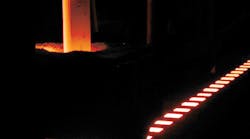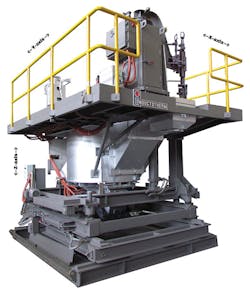Latest from Melt/Pour
Affordable Automated Pouring for Flask and Flaskless Horizontal and Vertical Molding Lines
In today’s competitive market, many ferrous and nonferrous foundries are surviving by diversifying their customer base. This provides product diversity to smooth out the peaks and valleys so typical of the metalcasting business. Metalcasting equipment suppliers understand the need to adapt to prevailing conditions, optimizing opportunities as they develop and create specific products for these new applications.
Automated pouring has been around for a long time and the advantages of the process are clear. These systems are much safer than manual pouring operations as they allow the operator to be positioned away from molten metal and wasteful over/underpours are reduced. Small to mid-sized foundries generally maintain that large automated pouring systems represent an unacceptably high investment, but now there is a new and affordable solution that can make automated pouring a must-have for any size foundry.
For lower-speed, cope and drag, and vertical flaskless mold lines, we’ve introduced a new, small to mid-size pressurized automated pouring system that has all the benefits of a larger system and made them available to more jobbing foundries.
The latest designed pressurized automated pouring system was built to have available two useable tons of molten metal. However this system has furnace capacities starting at 1.5 metric tons and the product line continues in capacities that match the standard Pressure Pour designs. The standard siphon arrangement is 90 degrees. This is a design detail adopted for worker safety, with consideration to different foundries’ overhead clearance factors. A 180-degree configuration is available too, depending on specific requirements.
The furnace can tilt partially for alloy changes or conversions, or tilt to 95 degrees to fully empty. It is also equipped with both X- and Y-axis motion, with 24 inches in either direction, for pouring different sprue/pouring basin locations. The system also has the ability to move vertically—along the Z-axis—a total of six inches for offering even greater flexibility to pour molds of various heights.
The key to all successful automated pouring is to adopt the best control system for a particular application. Standard pouring on these systems is possible through manual controls utilizing a camera for operator observation. However, the system can be upgraded easily to Teach Mode (a taught profile) or VISIPOUR P3 (vision-based) technologies, for additional benefits. Be sure to review the variety of computerized control systems, ranging from joystick-based operator-run systems, to the more advanced and reliable vision-based system.
There are a number of ways to power the pouring system, from a single-phase tap changer to a three-phase solid-state power supply. Typically, power is selected according to the level of superheating required for a particular pattern, or alloy changes to suit each specific application. The system is thermally efficient and is designed with Inductotherm’s conservative lining configuration.
The product is compatible with flask and flaskless horizontal molding as well as vertical flaskless molding. Many horizontal molding machines can produce variable cope and drag thicknesses, hence the Z-axis movement to accommodate this change. The furnace capacity is well-suited for production rates of up to 6 tons/hr., and is an ideal, economically feasible solution for many diversified foundries where production rates on these mold lines are lower.
Small to mid-size foundries will find automated pouring to be a safe, economical and versatile way to create a flexible, highly productive business.
William R. Pflug is the Product Manager for Automated Pouring Systems at Inductotherm Corp. Contact him at [email protected], or visit www.inductotherm.com.










